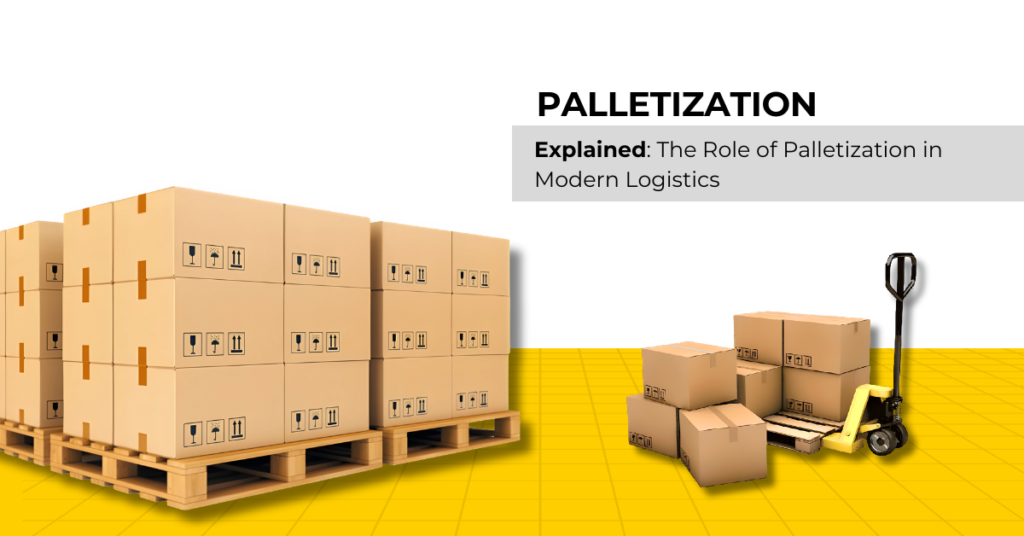
Palletization is a crucial logistics process that involves placing goods on a pallet to consolidate the load, making it easier for handling equipment to transport it. This method not only facilitates transportation but also ensures the protection of merchandise from the start of palletization to its final destination, maintaining the product in perfect condition throughout the logistics process.
What is Palletization?
Palletization is the process of stacking goods on a horizontal platform called a pallet, which is typically made of wood, plastic, or metal. This platform provides a stable base for the products, allowing forklifts or pallet jacks to pick up and move the load as a single unit. The choice of pallet material and size, such as GMA pallets, half pallets, or Euro pallets, depends on various factors including storage systems, handling equipment, the type of product, and the company’s suppliers.
Advantages of Palletization
- Efficient Loading and Unloading: Pallets streamline the loading and unloading process, enabling operators or automated systems to move freight quickly and efficiently.
- Streamlined Goods Flow: Products on pallets can be easily moved around the warehouse, ensuring that each item reaches its designated stage in the logistics process on time.
- Improved Safety: Pallets prevent workers from handling individual loads, reducing the risk of injury and product damage.
- Enhanced Inventory Control: Palletizing loads allows for better monitoring of stock levels, as logistics managers can easily assess the volume of merchandise stored on each pallet.
- Optimized Storage Space: Pallets enable the efficient use of warehouse space, with stackable storage systems maximizing the available area.
History of Palletization
The concept of palletization emerged in the early 20th century when US businesses started using wooden skids to handle heavier products. The modern pallet was developed during World War II, allowing armies to quickly transport large quantities of supplies. Since then, pallets have become integral to the supply chain, facilitating goods receipt, storage, and delivery in both traditional and automated warehouses.
The Palletization Proces
The palletization process involves two main phases: loading and securing the goods. First, unit loads are stacked uniformly on the pallet, ensuring even weight distribution to prevent deformation and risk. Once stacked, the goods are secured using transparent film in a stretch wrapping process, creating a compact and stable structure. Still feeling overwhelmed and don’t know whom to trust Request a Callback from our Expert !
Palletization in the E-commerce Era
While pallets remain vital in industries like industrial, food, and automotive, the rise of e-commerce has led to the use of smaller load units such as boxes, especially in sectors like retail and fashion. Nonetheless, proper palletization is essential in automated and semi-automated warehouses to prevent goods from toppling and ensure smooth operations.
Use Cases of Palletization
- Food and Beverage Industry: Palletization is critical in this sector for handling large quantities of perishable goods. Pallets ensure that products like fruits, vegetables, and beverages are transported quickly and safely, maintaining their quality.
- Automotive Industry: Heavy automotive parts are palletized to facilitate safe and efficient transportation. Pallets help in managing bulky items such as engines, transmissions, and other car parts, ensuring they reach assembly lines intact.
- Retail and E-commerce: Retailers use palletization to streamline the distribution of goods to stores and directly to consumers. In e-commerce, pallets help in organizing and transporting various products in warehouses, ensuring timely delivery.
- Pharmaceutical Industry: Sensitive products like medicines and medical equipment require careful handling. Palletization provides the stability and protection needed to ensure these items remain uncontaminated and undamaged during transport.
- Manufacturing Sector: Manufacturers use palletization to handle raw materials and finished products. This process ensures efficient movement within factories and to external locations, supporting lean manufacturing principles.
Benefits of Palletization
- Faster Handling: Palletized goods can be moved more quickly, reducing turnaround times for delivery vehicles and minimizing labor requirements.
- Increased Efficiency: Standardized pallet sizes streamline warehouse operations and improve storage efficiency.
- Minimized Risks: Palletization reduces the risk of worker injuries and product damage during handling and transport.
- Ease of Transportation: Managing a single pallet with multiple products is more efficient than handling individual items, and standard-sized pallets can be easily moved using forklifts and pallet jacks.
The Bottom Line
Palletization is a vital component of modern logistics, offering numerous benefits in terms of efficiency, safety, and cost savings. By understanding and implementing proper palletization techniques, businesses can enhance their supply chain operations and ensure the safe and efficient transport of their products. For tailored palletization solutions, companies like Interlake Mecalux provide expert consulting and a wide range of traditional and automated storage systems to meet diverse logistical needs.







